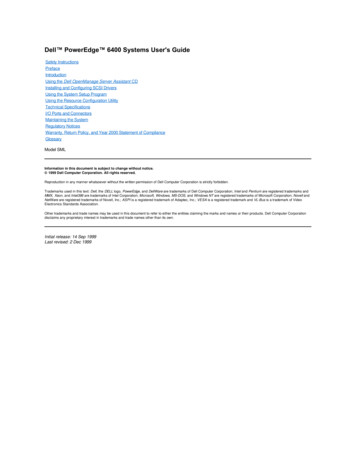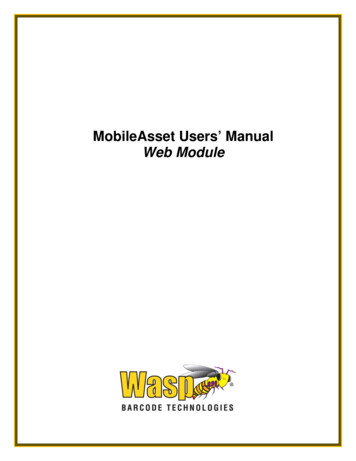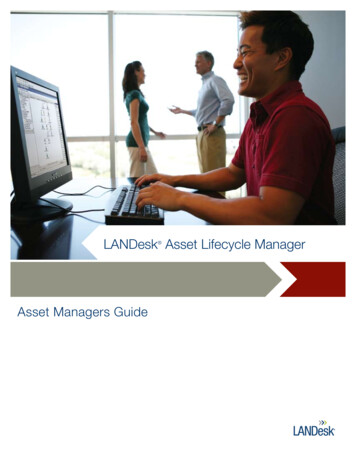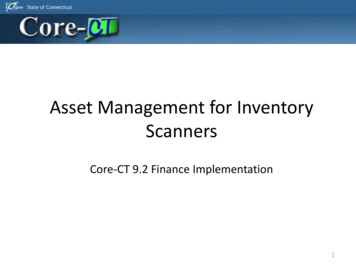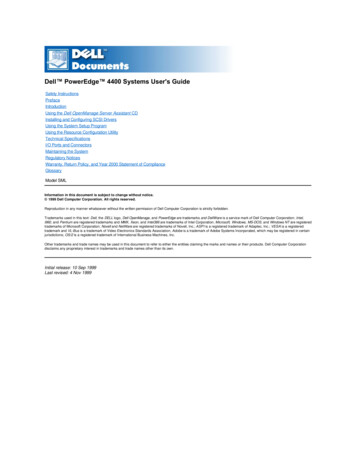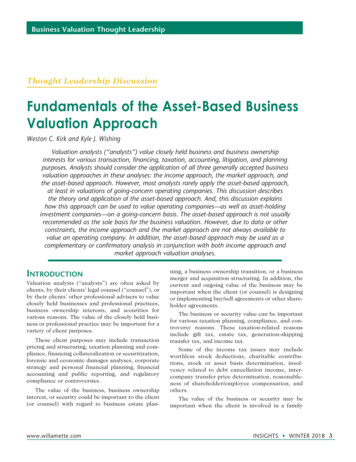
Transcription
Business Valuation Thought LeadershipThought Leadership DiscussionFundamentals of the Asset-Based BusinessValuation ApproachWeston C. Kirk and Kyle J. WishingValuation analysts (“analysts”) value closely held business and business ownershipinterests for various transaction, financing, taxation, accounting, litigation, and planningpurposes. Analysts should consider the application of all three generally accepted businessvaluation approaches in these analyses: the income approach, the market approach, andthe asset-based approach. However, most analysts rarely apply the asset-based approach,at least in valuations of going-concern operating companies. This discussion describesthe theory and application of the asset-based approach. And, this discussion explainshow this approach can be used to value operating companies—as well as asset-holdinginvestment companies—on a going-concern basis. The asset-based approach is not usuallyrecommended as the sole basis for the business valuation. However, due to data or otherconstraints, the income approach and the market approach are not always available tovalue an operating company. In addition, the asset-based approach may be used as acomplementary or confirmatory analysis in conjunction with both income approach andmarket approach valuation analyses.IntroductionValuation analysts (“analysts”) are often asked byclients, by their clients’ legal counsel (“counsel”), orby their clients’ other professional advisers to valueclosely held businesses and professional practices,business ownership interests, and securities forvarious reasons. The value of the closely held business or professional practice may be important for avariety of client purposes.These client purposes may include transactionpricing and structuring, taxation planning and compliance, financing collateralization or securitization,forensic and economic damages analyses, corporatestrategy and personal financial planning, financialaccounting and public reporting, and regulatorycompliance or controversies.The value of the business, business ownershipinterest, or security could be important to the client(or counsel) with regard to business estate plan-www.willamette.comning, a business ownership transition, or a businessmerger and acquisition structuring. In addition, thecurrent and ongoing value of the business may beimportant when the client (or counsel) is designingor implementing buy/sell agreements or other shareholder agreements.The business or security value can be importantfor various taxation planning, compliance, and controversy reasons. These taxation-related reasonsinclude gift tax, estate tax, generation-skippingtransfer tax, and income tax.Some of the income tax issues may includeworthless stock deductions, charitable contributions, stock or asset basis determination, insolvency related to debt cancellation income, intercompany transfer price determination, reasonableness of shareholder/employee compensation, andothers.The value of the business or security may beimportant when the client is involved in a familyINSIGHTS WINTER 2018 3
law dispute, commercial bankruptcy matter, shareholder dispute, lender liability claim, infringementclaim, many types of breach of contract claims, andmany types of breach of fiduciary duty or other tortclaims.approach in the typical closely held business orsecurity valuation. This is because these analysts(and clients and counsel) are not sufficiently familiar with the generally accepted methods and procedures within this business valuation approach.Such litigation-related matters may include dissenting shareholder appraisal rights claims andshareholder oppression claims.In addition, many analysts (and clients andcounsel) labor under misconceptions about when—and when not—to apply this valuation approach.And, many analysts (and clients and counsel)also hold misconceptions about interpreting thequantitative results of the asset-based valuationapproach.Generally Accepted BusinessValuation ApproachesRegardless of the purpose of the closely held business or security valuation, analysts should consider all three generally accepted business valuationapproaches. These approaches (or categories ofrelated business valuation methods) are as follows:1.The income approach2.The market approach3.The asset-based approachAlthough less commonly applied than the incomeapproach or the market approach, the asset-basedapproach is a generally accepted business valuationapproach. The asset-based approach is describedin most comprehensive business valuation textbooks. In addition, consideration of the asset-basedapproach is required by most authoritative businessvaluation professional standards.For example, professional standards such as theAmerican Institute of Certified Public Accountants(“AICPA”) Statement on Standards for ValuationServices (“SSVS”) and the Uniform Standards ofProfessional Appraisal Practice (“USPAP”) requirethe valuation analyst to at least consider the application of the asset-based approach (in addition toother business valuation approaches).That is to say, such professional business valuation standards require the consideration of—butnot necessarily the application of—the asset-basedapproach.In practice, however, many analysts (and manyclients and legal counsel) immediately reject theuse of asset-based approach methods in a business, professional practice, or security valuation.These analysts conclude that this approach is toodifficult, too time consuming, too client disruptive, or simply (and only without adequate explanation) not applicable to the subject closely heldcompany.In truth, many analysts (and clients and counsel)do not seriously consider applying the asset-based4 INSIGHTS WINTER 2018Hopefully, this discussion will correct many ofthe common misconceptions about this businessvaluation approach. This discussion will present themost important considerations that analysts, clients, and clients’ professional advisers need to knowwith regard to the asset-based approach valuation ofclosely held companies, professional practices, andbusiness securities.As will be discussed below, the proper application of this business valuation approach requiresa slightly different set of skills than does theapplication of the income approach or the marketapproach. Not all analysts have the experience orexpertise to perform a comprehensive asset-basedapproach business valuation analysis.It is also true that the completion of the assetbased approach often requires more analyst timeand associated cost than other business valuationapproaches. That additional analyst time typicallytranslates into additional professional fees chargedto the client. Therefore, clients often discourage theuse of the asset-based approach when they come tolearn of both (1) the additional elapsed time and (2)the additional costs associated with this particularvaluation analysis.Also, the successful performance of this valuation approach often requires more data from—andmore involvement by—the subject closely heldcompany executives. Again, when these additionalcommitments are understood, many clients maydiscourage the use of the asset-based approach.In many dispute-related business valuationassignments, the analyst may not be granted sufficient access to the closely held company facilitiesor to the closely held company executives in orderto practically implement this valuation approach.In addition, particularly in a retrospectiveassignment, the subject company data that theanalyst needs—and the subject company personnelthat the analyst needs access to—are simply nolonger available. In many of these controversyrelated contexts, it may simply be impractical forwww.willamette.com
the analyst to perform some asset-based approachvaluation methods.This first discussion in this three-part seriesof Insights discussions relates to the applicationof the asset-based business valuation approachwithin a transaction, taxation, or controversy context. This Insights discussion describes the theoryof—and the general application of—the asset-basedapproach.The second discussion in this three-part seriesof Insights discussions describes and illustrates acommon asset-based approach valuation method—the asset accumulation (“AA”) method. The AAmethod involves the identification and valuationof each individual category of the company assets(both tangible and intangible).And, the final discussion in this three-part seriesof Insights discussion describes and illustrates theadjusted net asset value (“ANAV”) method. TheANAV method involves a single aggregate allocationof all of the company’s total collective assets.Theory of the Asset-BasedApproachThe asset-based approach is sometimes called theasset approach to business valuation. Either namefor this approach is generally accepted among valuation analysts and in the valuation literature.The asset-based approach encompasses a set ofmethods that value the company by reference to itsbalance sheet. In contrast, income approach andmarket approach valuation methods primarily focuson the company’s income statement and/or cashflow statement.One of the very first procedures in any closelyheld business valuation is to define the businessownership interest subject to valuation. That is, theassignment should specify whether the valuationintended to conclude a defined value for the subjectcompany:1.total assets,2.total long-term interest-bearing debt andtotal owners’ equity,3.total owners’ equity, or4.one particular class of owners’ equity.Each of the above descriptions is a valid objective of a business valuation. And, each conclusionis often referred to as a “business value.” Yet, eachof these business value conclusions will be quantitatively different for the same company. And, eachwww.willamette.comof these business value conclusions will be perfectly appropriate in the right circumstance—usuallybased on the actual or hypothetical transaction thatis being analyzed.For example, knowing the company’s total assetvalue is necessary in an acquisition structured asan asset purchase (instead of as a stock purchase).The company’s total invested value (“TIC”)—oftencalled the market value of invested capital (or“MVIC”)—is the value of all long-term debt plus allclasses of owners’ equity. Knowing the value of theTIC is important in a deal structure where the buyerwill acquire all the company’s equity and assume allof the company’s debt.Knowing the value of the total owners’ equity isimportant when only the company’s equity securities (say all common stock and all preferred stock)are at issue in the transaction.And, knowing the value of one particular class ofequity only (say only the company’s common stock)is important when only that class of security is thesubject of the proposed transaction.In any event, the asset-based approach is basedon the principle that the value of the subject company is equal to:the value of the subject company’s total assetsminusthe value of the subject company’s total liabilitiesIf properly applied, this valuation formula canbe used to indicate the value of any of the valuationobjectives listed above. There are two particularlyimportant words in the asset-based approach valuation formula defined above:1.Value2.TotalFirst, the asset-based approach is based on thevalue of (and not the recorded balance of) all of theassets and all of the liabilities of the subject company. The standard of value in the analysis has to bedefined. And, the valuation date of the analysis hasto be defined. The standard of value is determinedby the assignment.Common standards of value for various businessvaluation purposes include fair market value andfair value. Other common standards of value includethe followingnInvestment valuenOwner valuenUse valueINSIGHTS WINTER 2018 5
“In the informationage, . . . intangibleasset categoriesoften represent themajor sources ofvalue for any subjectbusiness entity.”nUser valueWhatever the assignment-specific standard ofvalue is, the value conclusion is likely going to bedifferent from the recordedaccount balances presented on the subject company’s balance sheet. Thosebalance-sheet-recordedaccount balances are probably presented in compliancewith GAAP, which typically includes a combinationof historical cost-based measures and GAAP-basedfair value measures.Second, the asset-based approach is also basedon the total of all of the subject company’s assetsand liabilities. GAAP-based balance sheets typicallyexclude major categories of company assets andcompany liabilities. For example, GAAP-based balance sheets do not record most internally createdintangible assets.In the information age, such intangible asset categories often represent the major sources of valuefor any subject business entity. This statement isobvious for technology-related entities. However,this statement is also true for most companies.Under U.S. GAAP, the values of an entity’s internally created employee relationships, supplier relationships, customer relationships, and goodwill arenot recorded on the entity’s balance sheet. Likewise,the value of the entity’s contingent liabilities are notrecorded under U.S. GAAP. Therefore, employeelawsuits, environmental claims, unresolved incometax audits, and other claims against the company aretypically not recorded on the entity’s balance sheet.Unlike the company’s GAAP-based balance sheet,the asset-based approach value-based balance sheetrecognizes the current value of:1.all of the company’s assets (tangible andintangible) and2.all of the company’s liabilities (recordedand contingent).To conclude the assignment—defined valuefor the company’s assets and liabilities (whetherindividually or collectively)—the analyst appliesgenerally accepted asset (and liability) valuationmethods.These valuation methods are categorized intothe three categories of generally accepted property6 INSIGHTS WINTER 2018valuation approaches: the income approach, themarket approach, and the cost approach.When to Apply the AssetBased ApproachFirst, it is noteworthy that, under most businessvaluation professional standards, the analyst shouldconsider the application of generally accepted valuation approaches. Accordingly, the relevant analystquestion is not: when should I perform the assetbased approach? Rather, the relevant analyst question should be: when can I not perform the assetbased approach?That is, as a general principle, the asset-basedapproach should at least be considered (if notcompleted) in every business valuation assignment. The reasons why an asset-based approachanalysis is not performed should be described inthe business valuation report. And, these reasonsshould be substantive and not perfunctory. In otherwords, the statement that “the subject companyis an operating company” may not be a sufficientexplanation.Second, the analyst’s selection of the applicablevaluation approach is a function of four primaryfactors:1.The type of subject company2.The type of subject business interest3.The type of subject transaction4.The availability of necessary dataMany clients (and their counsel and other professional advisers) believe that the asset-basedapproach is only applicable to so-called assetintensive companies. This statement is technicallycorrect. However, this conclusion ignores the realitythat virtually every company is an asset-intensivecompany.The fact is that the asset-based approach isapplicable to tangible-asset-intensive companiesand to intangible-asset-intensive companies.Virtually all companies are either tangible-assetintensive or intangible-asset-intensive (or a combination of both asset types). Therefore, at least foranalysts who are qualified to perform intangibleasset valuations, the asset-based approach is applicable to most types of companies.Many clients (and their counsel and other professional advisors) also believe that the assetbased approach is only applicable to so-called assetholding (or investment management) companies.www.willamette.com
Rather, this valuation approachis applicable to any companythat owns assets. Therefore, theasset-based approach may applyin the valuation of asset holdingcompanies, and the asset-basedapproach may apply in the valuation of asset operating companies.And, just about every companyfalls into one (or both) of thesetwo descriptive categories.In other words, at least foranalysts who are qualified to perform asset valuations on a goingconcern premise of value basis,the asset-based approach is applicable to the valuation of mosttypes of closely held companies orprofessional practices.The type of valuation subjectinterest may influence the selection of the valuation approach.This is because the asset-based approach (withoutadjustment) concludes a controlling, marketableownership interest level of value. Therefore, assetbased approach is particularly applicable to the valuation of an overall business enterprise—a valuationobjective that often relates to a business purchase orsale transaction.Alternatively, the asset-based business valuation approach is not particularly applicable to thevaluation of a nonmarketable, noncontrolling blockof nonvoting common stock—a valuation objectivethat often relates to (say) a tax planning, compliance, or controversy assignment.As the previous paragraphs imply, the type ofthe subject transaction (or the type of the subjectassignment) influences the selection of the valuation approach.An overall business valuation is well-served bythe asset-based valuation approach. That is, thisvaluation approach is particularly applicable to acompany merger and acquisition analysis, a stockexchange ratio analysis, a fairness opinion, a solvency opinion, or to the analysis of any other transaction involving the overall business enterprise.It is noteworthy that the asset-based approach isparticularly applicable to the analysis of a companyacquisition that is structured as an asset purchasetransaction (as compared to a stock purchase transaction). This is because the deal price is directlyrelated to the value of the subject company tangibleassets and intangible assets.www.willamette.comThe asset-based approach is also applicable tothe analysis of any transaction that is structured asa taxable transaction (as compared to a nontaxabletransaction tax structure). This is because the transaction deal price will depend on the prospectivedepreciation and amortization expense and incometax rates associated with the revalued tax basis ofthe transferred assets.The asset-based valuation approach is particularly applicable to analyses performed for assetbased secured financing purposes. In such aninstance, different creditors could have differentclaims on different asset classes. And, this valuation approach is particularly applicable for varioustaxation-related assignments, such as a closely heldcompany conversion from C corporation tax statusto S corporation tax status.Finally, the quantity and quality of available dataaffects the analyst’s selection of a business valuationapproach. For example, the fact that there are nosufficiently comparable publicly traded companiesin the subject industry sector affects the analyst’sability to use the market approach guideline publicly traded company method.The fact that there are no sufficiently comparable merger and acquisition transactions in thesubject industry sector affects the analyst’s abilityto use the market approach precedent transactionmethod.Likewise, the fact that there is no prospectivefinancial information in existence at the subjectcompany affects the analyst’s ability to use theincome approach discounted cash flow method.INSIGHTS WINTER 2018 7
If the analyst has no access to company assetspecific information (e.g., no available informationregarding the company’s individual tangible assetsor intangible assets), this fact will affect the analyst’s ability to use the asset-based approach AAmethod.If the analyst is working for the outside partyin a transaction or in a litigation proceeding, thisfact may affect the analyst’s ability to obtain sufficient data (or sufficient asset access) to use the AAmethod. And, if the valuation is retrospective—andall of the company’s tangible and intangible assetshave materially changed since the valuation date—this fact may affect the analyst’s ability to use theAA method.Nonetheless, the above-mentioned data limitations primarily relate to the AA method. Assetspecific data limitations, asset access limitations,and retrospective valuation dates are less importantin the application of the ANAV method (than theyare to the application of the AA method).Therefore, these issues may affect the analyst’sselection of which asset-based approach valuationmethod to apply. But, these issues do not necessarily eliminate the application of all asset-basedapproach considerations.Finally, the most relevant reasons why analystsdo not apply the asset-based valuation approach inlaw-related engagements are as follows:1.There are additional costs and time requirements associated with this approach.2.The audience for the valuation (includingcompany board of directors, legal counsel,and the judicial finder of fact) may not beparticularly familiar with asset-based valuation analyses.The Asset-Based Approach IsNot the Cost ApproachThe asset-based approach is a generally acceptedbusiness valuation approach. The cost approach isa generally accepted property valuation approach.This is a very important distinction.The objective of the asset-based approach is toestimate a business equity (or total net asset) value.The objective of the cost approach is to estimate thevalue of an individual tangible asset or intangibleasset.In the asset-based approach, the individual assetcategories may be valued using the cost approach,the market approach, or the income approach. Inthe typical asset-based approach analysis, the ana-8 INSIGHTS WINTER 2018lyst may expect that all of the property valuationapproaches will be used.Some asset categories will be valued by referenceto cost approach methods. Some asset categorieswill be valued by reference to market approachmethods. And, some asset categories will be valuedby reference to income approach methods.In fact, as a general rule, at least one of the subject company’s asset categories will be valued byreference to an income approach property valuationmethod, typically either:1.a capitalized excess earnings method(“CEEM”) or2.a multiperiod excess earnings method(“MEEM”).In the typical asset-based approach analysis,these income approach property valuation methodsare used to conclude whether:1.there is intangible value in the nature ofgoodwill for the subject company (i.e., apositive CEEM indication) or2.there is an economic obsolescence adjustment that needs to be made to the costapproach tangible and intangible asset values (i.e., a negative CEEM indication).There are several generally accepted costapproach valuation methods. The following costapproach methods can be used to value manytangible asset categories and intangible asset categories:1.Reproduction cost new less depreciationmethod2.Replacement cost new less depreciation3.Trended historical cost less depreciationmethodHowever, these cost approach methods are notparticularly applicable to all tangible and intangibleasset categories. Many tangible and intangible assetsare more efficiently valued by reference to the market approach. And, in particular, many intangibleassets are more efficiently valued by reference tothe income approach.For example, in a business valuation, it is possibleto value a company’s goodwill by reference to the costapproach (e.g., the capitalization of the lost incomeopportunity cost during a total asset recreationperiod). However, in the typical business valuation,it is more common for analysts to value a company’sgoodwill using the CEEM of the income approach.www.willamette.com
In summary, the cost approach can be used tovalue various categories of company tangible assets(e.g., machinery and equipment) or intangibleassets (e.g., a trained and assembled workforce).However, it is practically impossible to value allof the assets of a going-concern company by usingthe cost approach exclusively. Such an analysismay ignore the income generation capacity of thecompany, and it may not appropriately encompasseither:1.the company’s goodwill (positive capitalizedexcess earnings) or2.the company’s economic obsolescence(negative capitalized excess earnings).Exhibit 1Client Investment Holding CompanyIllustrative Asset and Liability CategoriesAssetsCash and money market instrumentsPublicly traded stocks and bondsOil and gas exploration/production interestsLand and land improvementsOptions and other derivative securitiesInterests in private entitiesThe asset-based business valuation approachtypically incorporates cost approach property valuation methods to value certain tangible and intangible asset categories. However, the asset-basedapproach also incorporates other property valuation approaches (i.e., the income approach and themarket approach) to value certain other tangibleand intangible asset categories of the subject company.Analysts (and clients and counsel and other professional advisers) who confuse the nomenclatureor the methodology of the cost approach versus theasset-based approach may not understand eithervaluation approach.The Asset-Based Approach IsNot Limited to Asset HoldingCompaniesThe premise of the asset-based approach is thatthe value of the company’s assets minus the valueof the company’s liabilities equals the value of thecompany’s equity.This formula doesn’t only work for the valuationof holding companies that passively own investmentassets. This formula also works for the valuationof operating companies that both own and operatetangible and intangible property.In practice, the asset-based approach oftenworks as well for operating companies as it does forinvestment holding companies. The primary differences in the two types of companies are the categories of the individual assets that are included in thevaluation analysis.For example, the illustrative categories of assetsand liabilities included in an investment holdingwww.willamette.comLess:LiabilitiesAccounts payable and taxes payableMortgages payableNotes payableEquals: Net asset valuecompany valuation analysis may include the itemslisted in Exhibit 1.An alternative example applies the same assetbased approach valuation formula to an operatingcompany. Illustrative operating company categoriesof assets and liabilities may include the items listedin Exhibit 2 on the following page.All assets can be valued using the generallyaccepted property valuation approaches and methods. This statement is equally true for tangibleassets and for intangible assets. And, this statementis equally true for investment assets and for operating assets.When an analyst asserts that the asset-basedapproach is only applicable to investment holdingcompanies, often the assertion should really be: “Ionly know how to apply the asset-based approachto investment holding companies; I really don’tknow how to value operating tangible and intangibleassets.”The more correct analyst assertion may be: “Theasset-based approach is ideally suited to the valuation of investment holding companies; however, theasset-based approach is also applicable to the valuation of operating companies.”INSIGHTS WINTER 2018 9
Exhibit 2Client Operating CompanyIllustrative Asset and Liability CategoriesAssetsCash, receivables, and inventoryLand and buildingsMachinery and equipmentTrademarks and trade namesTrained and assembled workforceCurrent customer (contract) relationshipsGoodwillLess:LiabilitiesAccounts payable and accrued expensesTaxes payableBonds, notes, and mortgages payableContingent liabilitiesEquals: Net asset valueThe Asset-Based ApproachDoes Not Conclude aLiquidation ValueMany analysts (and clients and counsel) believe thatthe application of the asset-based approach concludes a liquidation value (that is, not a going-concern value) for the subject company. These analysts(and clients and counsel) maintain this (erroneous)belief whether the asset-based approach is appliedto an investment holding company or to an operating entity.These analysts (correctly) believe that the assetbased approach is based on a defined value for thesubject assets. And, the defined value (whateverstandard of value applies) is usually based on theexpected sale price of the subject asset betweensome defined parties.However, these analysts (incorrectly) assumethat any sale of any asset is a liquidation transactionthat yields a liquidation value. This analyst belief issimply misplaced.Let’s use the fair market value (“FMV”) standard of value as an example. An FMV transactionoccurs between a hypothetical willing buyer and10 INSIGHTS WINTER 2018a hypothetical willing seller. Presumably, the assetbuyer is always willing to enter into the subject FMVtransaction.If the asset seller decides to sell the subjectasset by the end of the week (say, because a loanpayment is coming due), that transaction mayresult in a liquidation value. Even if the sellerexposes the subject asset for sale during a normalmarket exposure period—if the buyer will notcontinue to operate the asset in a going-concernbusiness—that asset sale transaction may result ina liquidation value.Now, let’s extend the example to assume thatthe seller has been operating the subject asset aspart of a going-concern company. Let’s assume thatthe seller exposes the asset for sale during a normal market exposure period. The buyer acquiresthe subject asset and then uses the acquired assetas part of the buyer’s going-concern company.Certainly, even the above-mentioned analysts wouldrecognize these asset sale transaction-based FMVindications as going-concern value (and not liquidation value) indications.In addition to individual operating assets beingsold from one going-concern seller to one goi
Fundamentals of the Asset-Based Business Valuation Approach Weston C. Kirk and Kyle J. Wishing Valuation analysts (“analysts”) value closely held business and business ownership interests for various transaction, financing,






